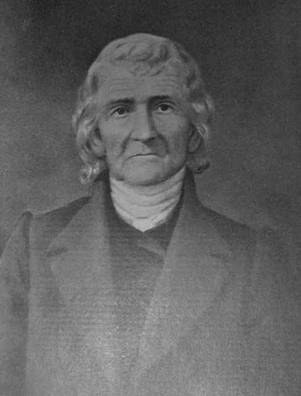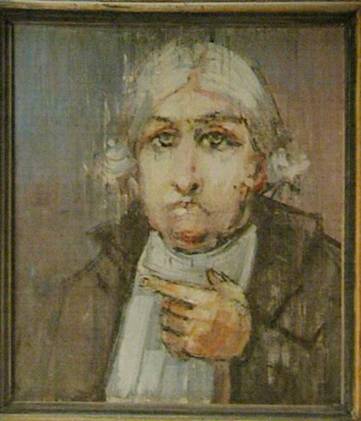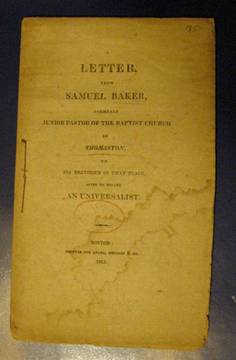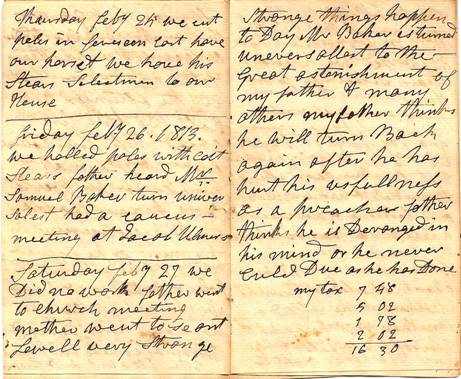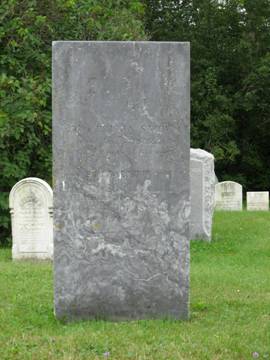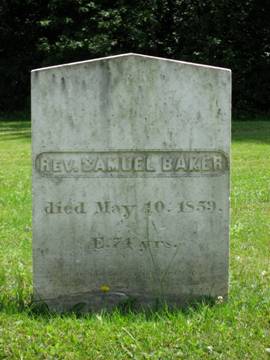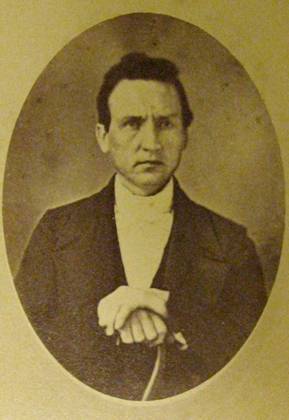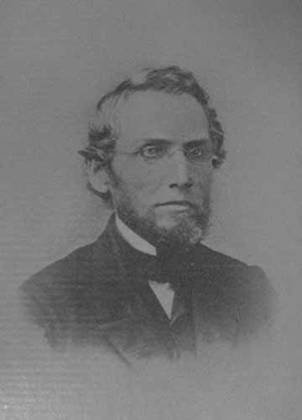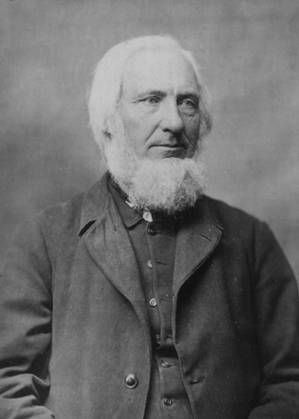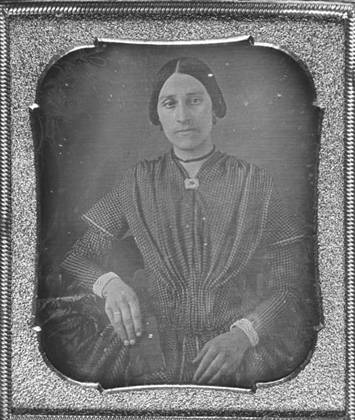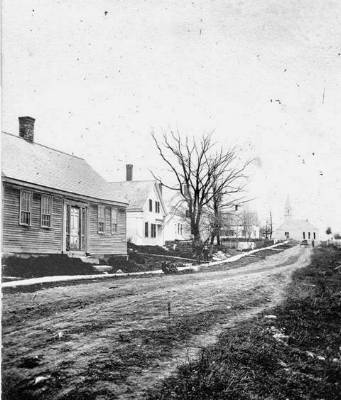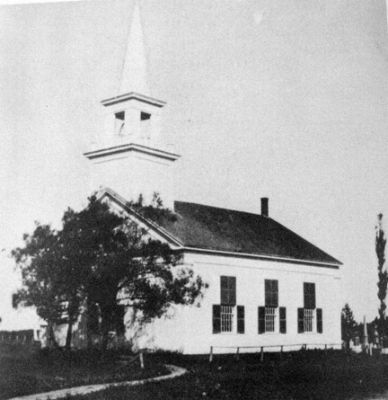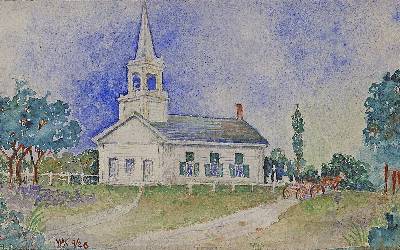|
FIRST BAPTIST CHURCH IN THOMASTON Our subject is the old Baptist church which once stood within sight of here up the street and adjacent to the Village Cemetery. It was the oldest Baptist church east of the Kennebec River (sixth oldest in the state) and the mother church of all the Baptist congregations in a thirty or forty mile radius of South Thomaston (except for several independent little churches that have sprung up in recent years). This is a natural subject for the Kalloch Reunion, not only because we are meeting this year in South Thomaston but also because two Kallochs were ministers in the First Baptist Church here and doubtless many Kallochs were members of this church as well. The early records of the church were lost in a schism in the church and the rest appear to be inaccessible as well. So most of our sources are indirect: Cyrus Eaton’s History of Thomaston, Rockland and South Thomaston of course is central. Millet’s History of the Baptists in Maine, Ricker’s Personal Recollections, another Baptist history, Burrage’s, History of the Baptists in Maine and Benedict’s A General History of the Baptist Denomination in America, give a Baptist perspective. I picked up bits from Richard Snow’s writings on his family, from an interesting web site with insights on Elijah Snow, from snippets from the Journals of Hezekiah Prince, Jr., and from Ben Ames Williams, Come Spring, from a sketch by Sandra Zimmerman’s grandmother, Aurelia S. Ripley, The Early Days of Wessaweskeag or South Thomaston as It Was Later Named and miscellaneous notes and clippings on Kallochs saved by members of my family. Bill Colby told me of a very useful source, a major report of the 100th Anniversary celebrations of the church in the Courier Gazette, July 1, 1884. Pictures shared by Chuck Hartman of the South Thomaston Historical Society added greatly. I did turn up two original sources: a pamphlet printed in 1813 with the long title, A Letter from Samuel Baker formerly Junior Pastor of the Baptist Church in Thomaston to His Brethren in That Place After He Became a Universalist, and a second source which is unpublished, The Ingraham Diaries kept from 1795 to 1878 by father and son, Joseph and Henry Ingraham of Ingraham’s Point in what is now Rockland. I also should mention that I was schooled on the Kalloch Baptists by many summers spent here in Rockland by my Great Aunt, Mabel Kalloch Rollins, who was a life-long member of the First Baptist Church in Rockland. I then went on to a career of serving Unitarian Universalist congregations for 40 years. All these influences and sources will make their presence known as this interesting church story unfolds. A sketch of the New England religious context out of which the story of the South Thomaston Baptist Church emerges in 1784 is important. Roger Williams is generally credited with being the original Baptist in New England. He was minister of the First Church in Salem, Massachusetts Bay Colony, for a brief period but had a run-in with Governor Winthrop over his views on land possession and wandered down to the Plymouth Colony to the First Church there where his ministry was even more brief! He then made his way into what is now Providence, Rhode Island, soon joined by lots of Quakers, followers of Ann Hutchinson, and others that didn’t fit. This colony was often nicknamed “Rogues’ Island” by the rest of New England. Roger Williams was only a Baptist for two or three weeks after which he labeled himself a “free thinker.” But he left us a priceless legacy, the principle of the separation of church and state. The actual beginning of Baptists as we later knew them in Thomaston was in Newport, Rhode Island, shortly after Williams. The rest of New England was Puritan or Congregational country, with no separation of church and state. The Congregational parishes were called the “Standing Order.” The District of Maine was part of Massachusetts until it became a state in 1820 when the separation of church and state here was instituted. If you wanted to incorporate a town in Massachusetts you had to form a Congregational Parish and support its ministry by taxation. From about 1755 on the Congregational parishes began to liberalize until by the turn of the 19th century there were two divisions in the established “Standing Order,” the Unitarian Congregationalists and the Trinitarian Congregationalists. Here in Thomaston when it finally gathered it was mixed. Henry Knox, a major benefactor, was a Unitarian, and several early ministers had liberal leanings, but others were more evangelical and all worshipped together with reasonable harmony. Meanwhile three non established religions were organizing in New England with considerable success. 1. The Baptists had the advantage of claiming, as the Congregationalists became more moderate and liberal, that they were the only Calvinist religion left holding truly to the principles of human depravity, predestination, salvation of the elect and atonement. We will soon see how this worked in South Thomaston. The Calvinism of the Baptists appealed particularly to the Scots-Irish settlers in the region who came from Presbyterian backgrounds in the old country. (In Warren for example the original Presbyterian parish had become part of the Congregational “standing order” and finally a Unitarian church. Much of the population had this Scots-Irish background -- including our Kalloch families -- the Baptists could tap into.) 2. The Methodists were also popular, appearing first in this region on Vinalhaven. Methodists believed that salvation was available to those who opted by faith to accept it and behaved themselves, sometimes known as Methodist “perfectionism.” 3. A third non established group were the Universalists who believed that the atonement was for everyone. This was called “universal salvation,” the logic being that if God created us, was all powerful and all good, of course we were saved. All three of these non established religions factor into the story of the First Baptist Church in Thomaston, now South Thomaston. The energy and passion for exacting theological distinctions has largely evaporated today. Most people dismiss the idea that they or their relatives and friends could land in a literal place called hell. In the age of moon landings and a Hubbell telescope circling Earth and viewing events 13 billion years ago the idea of a literal heaven “up there” has faded. But in 1784 these ideas were alive and distinctions about them critical. There are five personalities that are key to understanding the early history of the South Thomaston Baptist Church. They were Elisha Snow, Samuel Brown, Chloe (or Mrs Oliver) Robbins, Isaac Case and Samuel Baker. These all came before Kallochs were involved in this church, except perhaps Finley Kelloch II who owned Spruce Head Island. Elisha Snow came to what is now South Thomaston in 1767. He obtained title to a huge tract of land in an unusual transaction with a Lieutenant in the British Navy. Snow left Boston with the title while the Lieutenant set sail for England and was never heard from again, nor was any promissory note, mortgage, or warrantee deed. He was presumably lost at sea. Neither Snow nor the Lieutenant’s heirs made contact so Snow was off the hook! Snow is listed on the Committee of Safety during the early Revolutionary period but after the capture of Castine by the British became a collaborator, for example hiding and feeding breakfast to the British kidnappers of General Wadsworth before they disembarked for Castine with their captive. It is amazing how he finessed his position after the war. Out in his garden he had a religious experience. As described by Eaton (pp.91-2):
The historian, Cyrus Eaton, was a Unitarian but describes well the conversion experience which typically preceded adult baptism or admission into a Baptist church of that time. After this experience Elisha Snow became an Elder among the Baptists, practicing for awhile in Harpswell before returning to South Thomaston as its second minister. On the opposite side of the Wessaweskeag River the church’s first Deacon, Samuel Brown, settled at the head of what became the Mill Pond with his land extending over to St. George Bay. He served on most committees in the town and was an original member of the church. Deacon Brown and the Elder Snow would soon be at loggerheads. Brown and Oliver Robbins were the first settlers in what is now South Thomaston in 1765. We meet Oliver Robbins and his wife, Chloe, early in the pages of Ben Ames Williams’ Come Spring. The younger Robbins family stepped off the boat and were taken in by Oliver and his wife in one of the first framed houses in Thomaston. The Robbins house faced the St. George River along what is now the St. George Road or Rte. 131. Chloe Robbins was said to have been the only “pious Baptist” in this part of Maine. The early meetings and eventually the church, were organized in the Robbins’ barn. (Oliver’s son, Otis married Mary Keen, sister of my 4th great grandmother.) It is likely that they were responsible for sending the “messengers” who intercepted a young minister in Newcastle named Isaac Case, inviting him to Thomaston.
An insight into Elisha Snow’s belief in “original sin” is portrayed in a legendary dialogue:
Of course there were few roads in 1784 and most people would attend in South Thomaston itself only rarely. If the going was muddy, icy, too cold, or in summer a good haying day, they would not be there. If the minister really wanted to build up the church he would get on his horse and preach in a living room of a parishioner out beyond an easy horseback or sleigh ride. This was also a good way to get a free meal. There was little cash among the frontier farmers. In fact Eaton reports that is likely why Elder Case moved on after 6 years. He had to feed his family, even if he had married Elisha Snow’s daughter who had seven brothers farming and sailing in the neighborhood. A non-Baptist took pity on Case and paid for moving his worldly goods. I inherited 80 years of diaries kept by father and son, Joseph and Henry Ingraham, between 1795 and 1875. Joseph, the father, was among the early members of the South Thomaston Baptist Church, serving as Treasurer. From their farm on Ingraham’s Point in Rockland to the church in South Thomaston was just over three miles. Every week they enter under Sabbath (always spelled “Saboth”) whether or not they went to the Keag (always spelled Keig). Henry, the son, noted in the Journal:
Again six months later on a Thursday:
Henry wrote two months later an entry which shows something of his theology:
Henry was baptized two months later and remained a Baptist the rest of his life, one of the 21 dismissed from South Thomaston to found the church in Rockland, where he was for many years the Treasurer. In 1798 the South Thomaston church finally decided it was time to build a meeting house. The pulpit was on one side with galleries on the other three sides. If you have been in the old Union church in Lincolnville Center you know how it might have looked. The steeple was added when the balconies were removed the windows widened and slip pews installed in 1847. The exterior was changed to a Greek Revival style. Alas, the old building burned in 1898, having stood on the high ground in Wessaweskeag village, next to where the cemetery is now, for 100 years. When Elisha Snow turned 69 he was tired and asked the church to bring another minister on board. Rural ministers not of the ‘standing order’ at this time had to feed, clothe and shelter their families with their own hands, in their gardens, fields and in their woodlots, cutting and splitting perhaps ten cords of wood for the winter. Elisha was tired. Soon along came a young 23 year old Methodist preacher so impressed with Snow that he converted.
There was a kind of father and son relationship, Snow the highly structured, tough minded, true-false, right-wrong, ‘tell ‘em what you’re going to say, say it, then tell ‘em what you said’ type of preacher and then Samuel Baker, feeling his way along, tender minded, always a seeker, warm hearted embracing young man. In 1808 this combination produced the greatest revival and increase in the church’s history. Elisha could now relax his grip a bit, not completely, for he was one of those people who didn’t have a clue as to how to retire. It was a good thing for Baptist fortunes here The people became very attached to his colleague or junior pastor, Samuel Baker. However, Baker in his searching of the scriptures began to change his views five years into his ministry here. The Ingraham Diaries pretty much trace the course of events. Through the eyes of Henry we learn:
Six months later on February 27, 1813 Henry writes:
Then a month later:
Still another month went by:
For a brief time father and son go in two directions:
They found it difficult to sever their fondness for Baker:
Samuel Baker was asked to officiate at funerals and other pastoral duties:
Isaac Spear and Henry’s brother, Charles, both drowned in 1814 in the south cove of Rockland harbor. Baker officiated at the Spear funeral, Snow at the Ingraham:
The church had been in arrears for Samuel Baker’s salary:
About this time Samuel Baker met another minister named Ames (likely Benjamin Eames of St. George) Their conversation gives some insight into the thinking of each man and went something like this:
Even after all of that the church hired Samuel Baker back for a brief year or two but it was not long before his heresy showed signs of returning. The exasperated Snow prayed:
There was a final falling out and Baker’s place was filled by Samuel Fogg for the next five years. At a community meeting where all three were in attendance Samuel Baker was asked to give the prayer:
Interesting enough, after a career as an itinerant Universalist preacher in many parts of Maine, Samuel Baker came back to Rockland to die and the two former colleagues, Snow and Baker are buried side by side in the South Thomaston Village Cemetery.
The next 35 years through 1855 were years of a relative stability, a peaceful plateau. This period included the ministries of Amariah Kalloch (1832-1834) and Joseph Kalloch (1843-1854). During Samuel Fogg’s ministry a Sunday School was organized in 1826 by none other than young Henry Ingraham, who now had a six year old daughter, Achsah, in 1837 to become the wife of Rev. Joseph Kalloch. After Fogg for about 17 years there were six brief ministries of less than three years each. Among them was that of Amariah Kalloch. We first met him in the West Rockport church in 1830 where he was ordained and in 1831 when he experienced a trial as his first child was born about two months earlier than the requisite nine months after marriage. In January the church there decided to forgive him but a year later in January of 1832 they voted to reconsider the decision. This likely precipitated his move to the church in South Thomaston where he served for three years. It appears Amariah was a restless magnetic personality, with a gift for preaching. As a movement developed in the Shore Village (now Rockland) to found a Baptist Church there (the Third Baptist Church in Thomaston) Amariah was called to be their first minister in 1834 and 21 members from the First Baptist Church here left with him. The Rockland church with his leadership became the largest in the association. He was widowed twice as he married three times: two sisters Mercy (m. 1830) and Sarah (m. 1842) Hathorn with a Sleeper between (Harriet, m. 1833) In 1849 Amariah left Maine to minister to the ‘49ers (in the gold rush) dying on arrival in Placerville, CA, of cholera. He was only 42.
My great-great-grandfather Joseph Kalloch’s tenure at First Baptist was a distant second to that of Elisha Snow. Like most Baptists at that time his preaching was from notes or extemporaneous. Only one sermon in Joseph’s handwriting has survived in the family. It was written expressly to be sent to the ‘49ers who had left from South Thomaston, “Sweatland, Hemenway and their associates.” He chose the unfortunate text of Ecclesiastes 10:19 and attempted to show the place of money when compared with “to fear God and keep his commandments.” The strength of Joseph Kalloch’s ministry seems to have been pastoral as he was usually asked in large gatherings to offer the prayer while others preached or lectured. He served other churches in the immediate area, First Baptist in St. George (twice), Second Baptist in Rockland (on Cedar St.), Waldoboro, Union and Searsmont, a return to South Thomaston and in his old age North Haven. When in St. George he was the founding minister of the Tenants Harbor Baptist Church. He officiated at 670 marriages and about 2500 funerals, perhaps a record in Knox County.
Four years into Joseph’s ministry, in 1847, the meeting house was completely remodeled. The building was turned from facing the river to facing the street. Thus the two doors faced west and the pulpit (often called “the desk”) was to the east. A handsome steeple was added. Pews were made more comfortable. Perhaps as in many congregations the pew ownership system had ended and not as many pews were required to accommodate the member families. Pictures show a chimney on the pulpit end. In the old format it was the custom to place woodstoves near the entrance running the chimney pipes the full length of the room under the ceiling exiting through the wall on either side of the pulpit. In the new arrangement there may have been a wood furnace below the floor using the one brick chimney. We can only conjecture. It appears the prosperity of a decade with the leadership of Joseph Kalloch was not to last. His successor David Perry served for five years (1855-59) followed by 16 years of stated supply preaching (1859-75) including a return of Joseph. After his second term of two years we know the names of only three preachers, C. M. Herring, S. P. Pendleton and _____ Prebble. There followed a time when the church was “destitute” until the tragic winter thunder storm of February 14, 1898, when ice sheathed the roof and lightening tore through the steeple burning it to the ground. Five years earlier the Maine Bible Society had done a door to door religious census of the town. Maine’s principal four religions measured: 166 Baptist families, 197 Methodist, 31 Universalist and 29 Congregational families in the town. Elders Case and Snow would have considered this grounds for rebuilding but it seems a different world had dawned as the opening decade of the twentieth century neared. A small Baptist church was constructed in 1900 at Ash Point but apparently activity was short lived and the building was demolished in 1956. We are left with a dramatic story of 114 years to remember and cherish.
© 2009 Peter Tufts Richardson |
